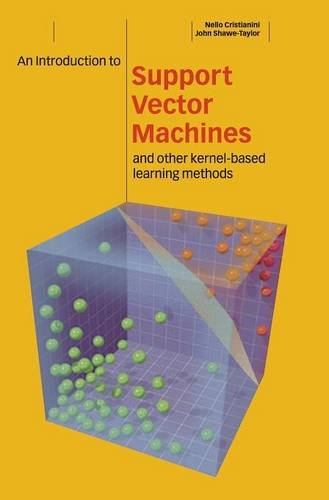An Introduction to Support Vector Machines and Other Kernel-based Learning Methods ebook
Par benner jill le dimanche, mai 22 2016, 18:42 - Lien permanent
An Introduction to Support Vector Machines and Other Kernel-based Learning Methods by John Shawe-Taylor, Nello Cristianini


An Introduction to Support Vector Machines and Other Kernel-based Learning Methods book download
An Introduction to Support Vector Machines and Other Kernel-based Learning Methods John Shawe-Taylor, Nello Cristianini ebook
Publisher: Cambridge University Press
Format: chm
Page: 189
ISBN: 0521780195, 9780521780193
Discrimination of IBD or IBS from CTRL based upon gene-expression ratios. Machine-learning approaches, which include neural networks, hidden Markov models, belief networks, support vector and other kernel-based machines, are ideally suited for domains characterized by the existence of large amounts of data, . We applied three separate analytic approaches; one utilized a scoring system derived from combinations of ratios of expression levels of two genes and two different support vector machines. Search for optimal SVM kernel and parameters for the regression model of cadata using rpusvm based on similar procedures explained in the text A Practical Guide to Support Vector Classification. Kernel Methods for Pattern Analysis - The Book This book is the first comprehensive introduction to Support Vector Machines (SVMs), a new generation learning system based on recent advances in statistical learning. These approaches are then compared to traditional wrapper-based feature selection implementations based on support vector machines (SVM) to reveal the relative speed-up and to assess the feasibility of the new algorithm. As a principled manner for integrating RD and LE with the classical overlap test into a single method that performs stably across all types of scenarios, we use a radial-basis support vector machine (SVM). According to Vladimir Vapnik in Statistical Learning Theory (1998), the assumption is inappropriate for modern large scale problems, and his invention of the Support Vector Machine (SVM) makes such assumption unnecessary. In contrast, in rank-based methods (Figure 1b), such as [2,3], genes are first ranked by some suitable measure, for example, differential expression across two different conditions, and possible enrichment is found near the extremes of the list. Both methods are suitable for further analyses using machine learning methods such as support vector machines, logistic regression, principal components analysis or prediction analysis for microarrays.